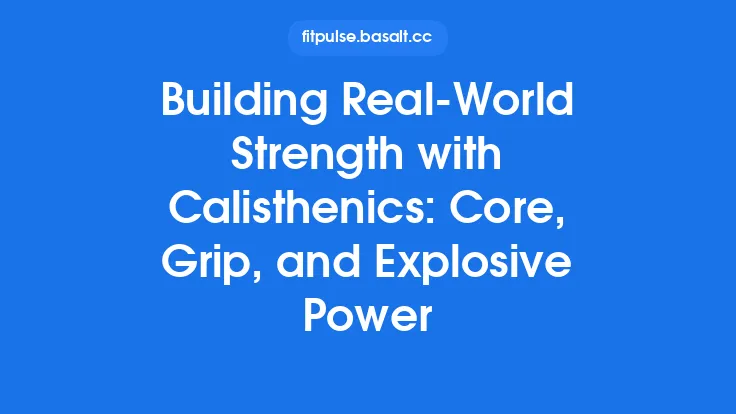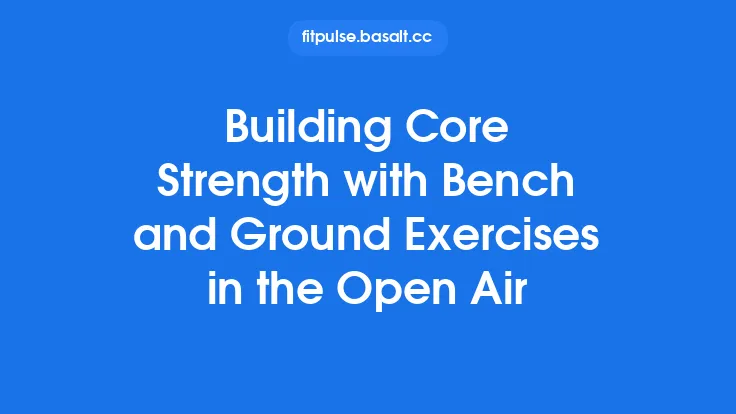Mastering Core Stability with a Parallettes‑Free Calisthenics Program
Minimal‑Equipment Calisthenics – Bodyweight & Calisthenics
When it comes to functional strength, athletic performance, and everyday health, a solid core is the foundation on which everything else is built. Yet many people assume that achieving a rock‑solid midsection requires fancy equipment, elaborate machines, or endless hours on the mat. In reality, a well‑designed calisthenics program—using nothing more than the floor, a small mat, and perhaps a lightweight object you already have at home—can develop core stability that rivals any gym‑based routine.
This guide walks you through the science, the movement patterns, and the progressive strategies you need to master core stability without a single pair of parallettes. Whether you’re a beginner looking to establish a reliable base or an experienced practitioner seeking to fine‑tune your midline, the principles and exercises outlined here will help you build a resilient, functional core that supports every other movement you do.
Understanding Core Stability
Core stability is more than just a six‑pack aesthetic; it’s the ability of the muscles surrounding the spine and pelvis to maintain a neutral, controlled position under load. This stability enables efficient force transfer from the lower body to the upper body (and vice‑versa), protects the lumbar spine from injury, and improves balance and posture.
Key components of core stability include:
- Neuromuscular Control – The brain’s ability to recruit the right muscles at the right time.
- Muscular Endurance – Sustaining low‑level contractions over extended periods (e.g., during a plank).
- Dynamic Strength – Generating force while the torso moves (e.g., during a mountain‑climber).
- Intra‑Abdominal Pressure (IAP) – The internal “cushion” created by coordinated diaphragm, abdominal, and pelvic floor activation.
A truly stable core can both resist unwanted movement (anti‑rotation, anti‑flexion, anti‑extension) and produce purposeful movement when required.
Anatomy of the Core
While the “six-pack” muscles (rectus abdominis) are the most visible, they represent only a fraction of the core’s functional architecture. Below is a concise map of the primary players:
| Muscle Group | Primary Function | Typical Activation in Calisthenics |
|---|---|---|
| Rectus Abdominis | Trunk flexion, assists in forced exhalation | Crunches, leg‑raises |
| External & Internal Obliques | Trunk rotation, lateral flexion, compression | Side planks, Russian twists |
| Transversus Abdominis (TA) | Deep stabilizer, creates IAP | All static holds, “drawing in” cue |
| Erector Spinae | Trunk extension, spinal alignment | Supermans, back extensions |
| Multifidus | Segmental spinal stability | Bird‑dogs, dead‑bugs |
| Pelvic Floor | Supports intra‑abdominal pressure, spinal loading | Integrated breathing cues |
| Diaphragm | Breath control, contributes to IAP | Breath‑focused bracing |
Understanding how these muscles cooperate allows you to select exercises that target specific stability demands rather than relying on a one‑size‑fits‑all approach.
Core Training Principles for a Parallettes‑Free Program
- Progressive Overload Through Time, Volume, and Complexity
- Time: Increase hold duration (e.g., from 20 s to 60 s).
- Volume: Add more sets or repetitions.
- Complexity: Introduce multi‑planar movements (e.g., plank with shoulder taps).
- Maintain a Neutral Spine
- The spine should retain its natural curves (cervical, thoracic, lumbar) throughout each movement. Use a mirror or video feedback to self‑correct.
- Prioritize Bracing Over “Squeezing”
- Think “tighten the whole midsection like you’re about to be punched in the gut,” rather than just pulling the belly button toward the spine.
- Integrate Breath
- Inhale deeply into the diaphragm, then exhale while bracing. This synchrony maximizes intra‑abdominal pressure.
- Balance Anti‑Flexion, Anti‑Extension, Anti‑Rotation, and Anti‑Lateral Flexion
- A well‑rounded program includes exercises that challenge each directional stability.
- Use Minimal Equipment Strategically
- A yoga mat for comfort, a small towel for grip, or a light sandbag for added load can enhance difficulty without compromising the “parallettes‑free” premise.
Core Exercises Without Parallettes
Below is a tiered list of movements, organized from foundational to advanced. All can be performed on a simple floor mat; optional props are noted.
1. Foundational Static Holds
| Exercise | Description | Progression Tips |
|---|---|---|
| Plank (Forearm) | Forearms on the mat, elbows under shoulders, body in a straight line. Engage TA, glutes, and quads. | Add leg lifts, shift weight side‑to‑side, or increase hold time. |
| Side Plank | Support on one forearm, stack feet, lift hips. | Raise the top leg, add a hip dip‑up cycle, or hold longer. |
| Dead‑Bug | Lying on back, arms extended toward ceiling, opposite arm/leg lowered while maintaining lumbar contact. | Add a light object (e.g., a water bottle) in the hand for added load. |
| Bird‑Dog | Quadruped position, extend opposite arm and leg, keep hips level. | Perform with a “pause‑and‑hold” at the top, or add a small towel under the hand for instability. |
2. Dynamic Anti‑Flexion & Anti‑Extension
| Exercise | Description | Progression Tips |
|---|---|---|
| Hollow Body Hold | Lie on back, lift shoulders and legs off the ground, press lower back into the mat, arms extended overhead. | Transition to Hollow Body Rock (small forward‑backward motion) or Hollow Body Pull‑Ups using a sturdy doorframe (if available). |
| Superman Hold | Prone position, lift chest, arms, and legs simultaneously, squeezing glutes and lower back. | Add alternating arm/leg lifts (Superman Alternating) or hold a light book in each hand. |
| Reverse Plank | Sit, place hands behind hips, lift hips to create a straight line from shoulders to heels. | Extend one leg at a time, or place a small cushion under the heels for increased range. |
3. Anti‑Rotation & Anti‑Lateral Flexion
| Exercise | Description | Progression Tips |
|---|---|---|
| Pallof Press (Band‑Free Variant) | Stand tall, clasp hands together, press forward while resisting rotational pull created by a partner’s gentle push. | Increase distance from partner, add a slow eccentric return. |
| Standing Windmills | Feet shoulder‑width, arms extended overhead, hinge at hips, rotate torso to bring opposite hand toward the floor while keeping hips square. | Hold a light object (e.g., a small pillow) in the top hand for added load. |
| Side‑Plank Hip Dips | From side plank, lower hips toward the floor, then lift back up. | Perform with a “pause‑and‑hold” at the bottom, or add a small sandbag on the top hip. |
4. Integrated Core‑Centric Calisthenics
| Exercise | Description | Progression Tips |
|---|---|---|
| Mountain Climbers | High‑plank position, drive knees alternately toward chest, maintaining a stable torso. | Slow the tempo for a “slow‑climb” version, or add a twist (bring knee toward opposite elbow). |
| L‑Sit Tuck (Floor Version) | Sit, place hands beside hips, lift hips and knees toward chest, hold. | Extend legs into a full L‑sit once strength permits, or place a small rolled towel under the sacrum for comfort. |
| Bear Crawl | Quadruped, knees slightly off the ground, move opposite hand‑foot pairs forward. | Increase distance, add a “pause‑and‑hold” at each step, or crawl laterally. |
Building a Progressive Core Program
- Assessment Phase (Week 1‑2)
- Test baseline hold times for plank, side plank, hollow body, and bird‑dog.
- Record form notes (e.g., “hips sagging,” “lower back arching”).
- Foundation Phase (Weeks 3‑6)
- Frequency: 3 sessions per week.
- Structure: 2 static holds + 2 dynamic moves per session.
- Volume: 3 sets per exercise, hold 20‑30 seconds for static, 8‑12 reps for dynamic.
- Stability‑Complexity Phase (Weeks 7‑10)
- Add anti‑rotation and anti‑lateral flexion moves.
- Introduce tempo variations (e.g., 3‑0‑1: 3 s eccentric, no pause, 1 s concentric).
- Increase total weekly volume by ~15 %.
- Power‑Integration Phase (Weeks 11‑14)
- Combine core moves with full‑body calisthenics (e.g., push‑up to plank, squat to hollow hold).
- Emphasize speed on dynamic moves while preserving form.
- Deload & Re‑Test (Week 15)
- Reduce volume by 40 % for recovery.
- Re‑measure hold times and compare to initial assessment.
Key Insight: Progression is not linear; listen to your body, and prioritize quality over quantity. If a hold deteriorates in form, regress to the previous level until stability returns.
Programming Tips for Everyday Life
- Micro‑Sessions: If you can’t commit to a full 30‑minute core block, perform “core bursts” of 3‑5 minutes (e.g., 2 × 30‑second planks, 2 × 10 dead‑bugs) 2‑3 times a day.
- Stacking with Other Movements: Pair a plank hold with a set of push‑ups, or perform a hollow hold while watching a TV show. This maximizes time efficiency.
- Travel‑Friendly Variations: In a hotel room, use a towel for side‑plank support or perform standing windmills in the bathroom.
Recovery, Mobility, and Maintenance
A strong core thrives on balanced tissue health. Incorporate the following into your weekly routine:
- Dynamic Stretching – Cat‑cow, thoracic rotations, and hip‑flexor mobilizations before core work.
- Foam Rolling / Self‑Myofascial Release – Target the thoracic spine, latissimus dorsi, and glutes to reduce tension.
- Breathing Drills – Diaphragmatic breathing while lying supine, focusing on expanding the belly and ribcage.
- Active Rest Days – Light yoga flow or a brisk walk to promote circulation without taxing the core.
Frequently Asked Questions
Q: Can I achieve a “six‑pack” solely with these exercises?
A: Visible abdominal definition depends on both muscle development and body fat percentage. The program builds the underlying musculature; a complementary nutrition plan is required for low enough body fat to reveal the definition.
Q: Do I need a mat?
A: A thin yoga or exercise mat improves comfort and provides a non‑slippery surface, but a carpeted floor works as well. The key is a stable, safe surface for hand and knee placement.
Q: How long before I see improvements?
A: Most people notice better posture, reduced lower‑back fatigue, and increased endurance in static holds within 3‑4 weeks of consistent training.
Q: Is it safe to train core daily?
A: Yes, provided you vary intensity and include active recovery. Light “maintenance” holds (e.g., 20‑second planks) can be done daily, while heavier sessions should be limited to 3‑4 times per week.
Q: Can I add external weight?
A: Absolutely. A small sandbag, a backpack filled with books, or a water jug can be placed on the torso during static holds to increase demand, but start with minimal load to preserve form.
Bringing It All Together
Core stability is the invisible engine that powers every push‑up, squat, sprint, and daily activity. By embracing a structured, equipment‑light calisthenics program—rooted in scientific principles, progressive overload, and mindful breathing—you can develop a resilient midline without ever needing a pair of parallettes.
Start with the foundational holds, respect the body’s alignment cues, and gradually layer in dynamic, anti‑rotation, and integrated movements. Track your hold times, listen to feedback from your own body, and adjust volume and complexity as you grow stronger.
With consistency, patience, and a focus on quality over quantity, you’ll not only achieve a stronger, more stable core but also enjoy the downstream benefits of better posture, reduced injury risk, and enhanced performance in every other workout you pursue.
Your journey to a rock‑solid core begins on the floor—no fancy gear required. Happy training!





